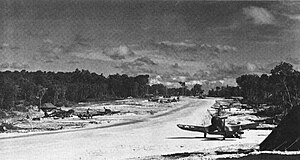Emirau Airport
Emirau Airport | |||||||||||
|---|---|---|---|---|---|---|---|---|---|---|---|
| Summary | |||||||||||
| Location | Emirau Island, Papua New Guinea | ||||||||||
| Elevation AMSL | 100 ft / 30 m | ||||||||||
| Coordinates | 1°38.5′S 149°58.5′E / 1.6417°S 149.9750°E | ||||||||||
| Map | |||||||||||
 | |||||||||||
| Runways | |||||||||||
| |||||||||||
Source: PNG Airstrip Guide[1] | |||||||||||
Emirau Airport is an airfield in Emirau Island, Papua New Guinea.[1]
History
World War II
| Emirau Airfield | |
|---|---|
| Emirau Island | |
 F4Us on Emirau | |
| Coordinates | 01°38.5′S 149°58.5′E / 1.6417°S 149.9750°E |
| Type | Military Airfield |
| Site information | |
| Controlled by | United States Marine Corps Royal New Zealand Air Force |
| Site history | |
| Built | 1944 |
| Built by | Seabees |
| In use | 1944-present |
| Materials | Coral |
Emirau was seized unopposed by two Battalions of the 4th Marine Regiment on 20 March 1944.[2] Naval Construction Battalions arrived shortly after the landings and began construction of two coral-surfaced 7,000 feet (2,100 m) by 150 feet (46 m) airfields on the island. Inshore Airfield had 35 double hardstands capable of parking 210 fighter or light-bomber planes, while North Cape Airfield had 42 hardstands with space for parking 84 heavy bombers. Both were fully equipped with towers, lighting, and a dispensary. The aviation tank farm consisted of three 1,000 barrels (~140 t) tanks and nineteen 1,000 barrels (~140 t) together with the appropriate filling and distribution points. A reserve of 40,000 barrels (~5,500 t) was stored in drums.[2]: 304 Emirau was the staging point for attacks on the Japanese strongholds at Rabaul and Kavieng.
US Marine Corps units based here included:
- VMSB-243 operating SBDs from June–December 1944
- VMB-413 operating PBJs[3]
- VMB-433 operating PBJs[4]
- VMB-443 operating PBJs[5]
- VMB-611 operating PBJs[6]
Royal New Zealand Air Force units based here included:[7]
- No. 1 Squadron operating PV-1s from May–June 1945
- No. 3 Squadron operating PV-1s
- No. 4 Squadron operating PV-1s from November 1944-February 1945 and June–July 1945
- No. 8 Squadron operating PV-1s from February–March 1945
- No. 9 Squadron operating PV-1s from March–May 1945
- No. 14 Squadron operating F4Us from July–August 1945
- No. 19 Squadron operating F4Us from November 1944-January 1945
- No. 22 Squadron operating F4Us from January–March 1945
- No. 23 Squadron from March–May 1945
- No. 25 Squadron operating F4Us from May–July 1945
There was also one Australian unit located on the island - the 474 Heavy Anti-aircraft Troop.
Base roll-up commenced in December 1944 and was completed by May 1945.[2]: 304
Postwar
The runways remain usable.
References
- ^ a b PNG Airstrip Guide. August 2005.
- ^ a b c Building the Navy's Bases in World War II History of the Bureau of Yards and Docks and the Civil Engineer Corps 1940-1946. US Government Printing Office. 1947. p. 303.
 This article incorporates text from this source, which is in the public domain.
This article incorporates text from this source, which is in the public domain.
- ^ http://www.vmb413.com/
- ^ http://www.vmb433.com/
- ^ http://www.vmb443.com/
- ^ http://www.vmb611.com/
- ^ "Royal New Zealand Air Force Operations from Emirau". Retrieved 12 June 2013.

